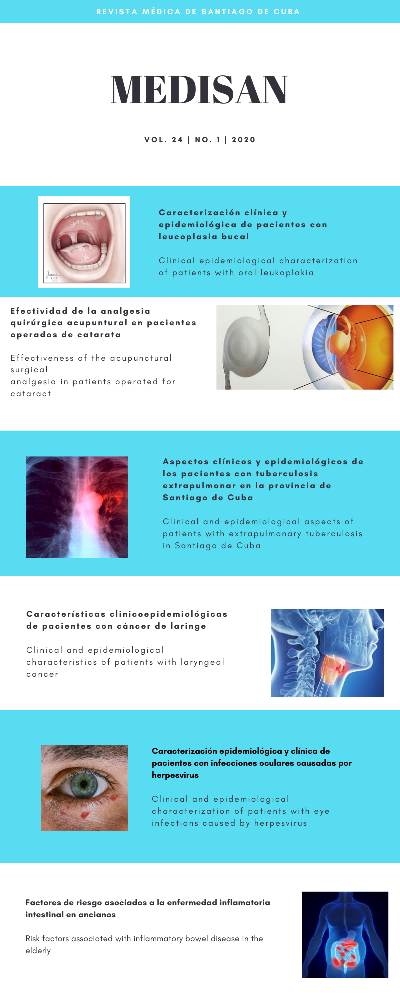Clinical and epidemiological characterization of patients with eye infections caused by herpesvirus
Keywords:
eye infection, herpes simplex virus, ophthalmopathy, eye affectation.Abstract
Introduction: Eye diseases originated due to virus occupy an important place in daily routine of the specialty.
Objective: To characterize patients with eye infections due to herpesvirus according to clinical and epidemiological variables of interest.
Method: A descriptive and cross-sectional study of 29 adult patients with infections due to herpesvirus was carried out, they were assisted in the ophthalmologic service of Dr. Juan Bruno Zayas Alfonso Teaching General Hospital inSantiago de Cuba, from September, 2012 to the same month in 2013.
Results: In the case material white skin patients (55.1 %), female sex (69.0 %) and 57 years and over age group (48.3 %) prevailed. Red eye and ciliumconjuntival injection constituted the most common symptoms and signs (75.9 %). The most frequent lesions were located in the eyelids, the skin and cornea (31.0 %). The affectation of the visual acuteness below 0.3 was related to the occurrence of stromal affectation and the localization of lesions in the pupilar area. No patient presented inflammation of the later segment.
Conclusions: Arguments about the existent relationship between the localization of lesions and the affectation of the visual acuteness were not found, which prevented to carry out comparisons.
Downloads
References
2. Abedi Kiasari B, Zare Tooranposhti Z. The changing epidemiology of herpes simplex virus type 1 infection: The associated effects on the incidence of ocular herpes. Archives of Razi Institute. 2016 [citado 08/10/2019]; 71 (2): 125-34. Disponible en: http://archrazi.areeo.ac.ir/article_106451_d292880921994bf92ebe26dd1f28c252.pdf
3. Zhu L, Zhu H. Ocular herpes: the pathophysiology, management and treatment of herpetic eye diseases. Virol Sin. 2014 [citado 08/10/2019]; 29 (6): 327-42. Disponible en: https://www.ncbi.nlm.nih.gov/pubmed/25547680
4. Hunt R. Virología. Herpes virus. Microbiología e Inmunología On-line. México: Universidad de Carolina del Sur. Instituto Politécnico Nacional; 2016 [citado 08/10/2019]. Disponible en: https://www.microbiologybook.org/Spanish-Virology/spanish-chapter11.htm
5. Muñoz Hiraldo E, Morillo Gutiérrez B. Infecciones por virus herpes simple. Grupo de Patología Infecciosa de AEPap. Infecciones por virus Herpes Simple. 2017 [citado 08/10/2019]. Disponible en: https://www.aepap.org/sites/default/files/documento/archivos-adjuntos/infecciones_por_virus_herpes_simple_.pdf
6. Alberdi Azcue A, Albisu Sánchez G, Alkorta Gurrutxaga M, Ansa Arlegui E, Azkune Galparsoro H, Balagué Gea L, et al. Guía de tratamiento de las enfermedades infecciosas en atención primaria (adultos). Gobierno Vasco: Comunicación. OSI Donostialdea; 2017[citado 08/10/2019]. Disponible en: https://lamochiladelresi.files.wordpress.com/2019/07/guia-enfermedades-infecciosas-ap-adultos-osi-donostialdea-osakidetza.pdf
7. Daoud Z, Ramos Amador JT, Morillo Gutiérrez B, Muñoz Hiraldo E. Infecciones por virus del herpes simple 1 y 2. En: Guía-ABE. Tratamiento de las infecciones en Pediatría. Guía rápida para la selección del tratamiento antimicrobiano empírico. Madrid: Guía-ABE; 2018 [citado 08/10/2019]. Disponible en: https://guia-abe.es/temas-clinicos-infecciones-por-virus-del-herpes-simple-1-y-2
8. Organización Mundial de la Salud. Virus del herpes simple. 2017. [citado 08/10/2019]. Disponible en: https://www.who.int/es/news-room/fact-sheets/detail/herpes-simplex-virus
9. Wu J. Una terapia doble podría ser un avance contra el herpes genital, sugiere un estudio con animales. Health Day News. 2019 [citado 12/10/2019]. Disponible en: https://consumer.healthday.com/espanol/sexual-health-information-32/herpes-simplex-genital-news-376/una-terapia-doble-podr-iacute-a-ser-un-avance-contra-el-herpes-genital-sugiere-un-estudio-con-animales-748971.html
10. Palmerín Donoso A, Tejero Mas M, Buitrago Ramírez F. Herpes zóster oftálmico. Atención Primaria. 2019 [citado 12/10/2019]; 51 (2). 123-4. Disponible en: https://www.ncbi.nlm.nih.gov/pmc/articles/PMC6837015/
11. Nithyanandam S, Dabir S, Stephen J, Joseph M. Características y severidad de La erupción en el herpes zoster oftálmico. Correlación com los resultados visuales, complicaciones oculares y neuralgia posherpética. lntern J Dermatol. 2009 [citado 12/10/2019]; 48: 484-7. Disponible en: https://www.intramed.net/contenidover.asp?contenidoid=60288
12. Montero Iruzubieta J, García Roldán A, Rodríguez Rodríguez J. Afectación de la córnea y la superficie ocular por el vírus del herpes simple. Superf Ocul Córnea. 2011 [citado 07/06/2018];8: 4-15. Disponible en: https://www.angelini.es/superficie-ocular-y-cornea-pdf/Superficie_ocular_y_cornea_8.pdf
13. Schmader K, George LK, Burchett BM, Pieper CF. Racial and psychosocial risk
factors for herpes zoster in the elderly. J lnfect Dis. 2010[citado
12/10/2019]; 178 (Supl 1): S67-70. Disponible en:
https://www.ncbi.nlm.nih.gov/pubmed/9852978
14. García González AI, Rosas Carrasco O. Herpes zoster (HZ) y neuralgia posherpética (NPH) en el adulto mayor: particularidades en la prevención, el diagnóstico y el tratamiento. Gac Med Mex. 2017[citado 12/10/2019];153: 92-101. Disponible en: https://www.anmm.org.mx/GMM/2017/n1/GMM_153_2017_1_092-101.pdf
15. Fano Machín Y, Estrada Abreu YC. Herpes zoster oftálmico. Presentación de un caso. Rev haban cienc méd. 2015 [citado 12/10/2019]; 14 (1). Disponible en: http://scielo.sld.cu/scielo.php?script=sci_arttext&pid=S1729-519X2015000100007
16. García F. Queratitis por herpes simple: revisión de literatura. Rev SCO. 2018; 51 (2): 105-14.
17. Moya Ramírez RE. Análisis de caso clínico sobre: queratitis epitelial herpética. Ambato: Universidad Técnica de Ambato, Facultad de Ciencias de la Salud; 2015 [citado 12/10/2019]. Disponible en: https://repositorio.uta.edu.ec/bitstream/123456789/14030/2/QUERATITIS%20EPITELIAL%20HERPETICA.pdf
Published
How to Cite
Issue
Section
License
All the articles can be downloaded or read for free. The journal does not charge any amount of money to the authors for the reception, edition or the publication of the articles, making the whole process completely free. Medisan has no embargo period and it is published under the license of Creative Commons, International Non Commercial Recognition 4.0, which authorizes the copy, reproduction and the total or partial distribution of the articles in any format or platform, with the conditions of citing the source of information and not to be used for profitable purposes.





